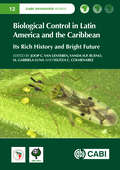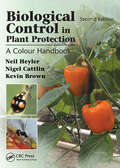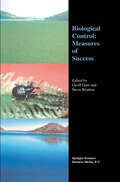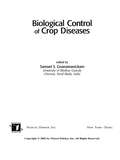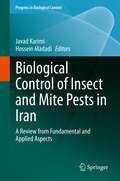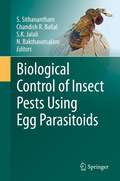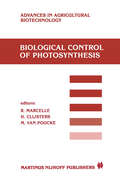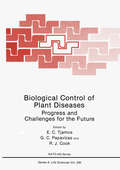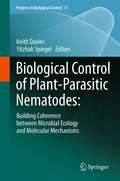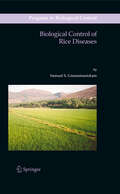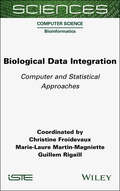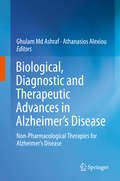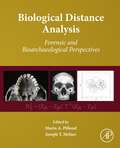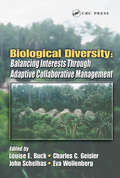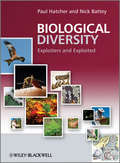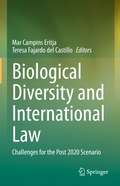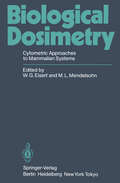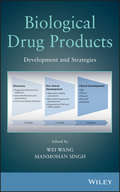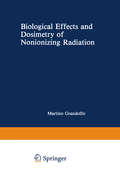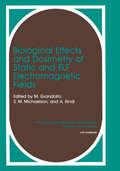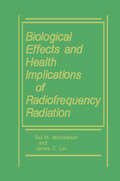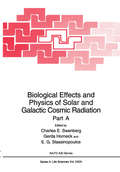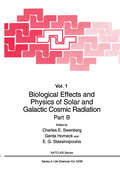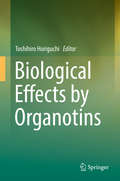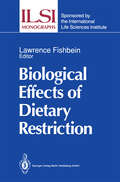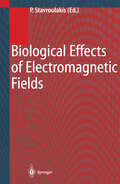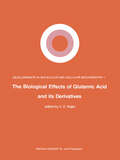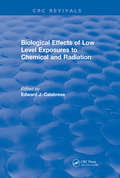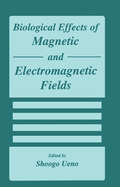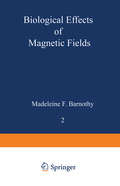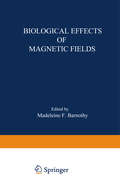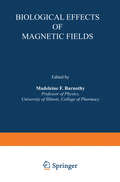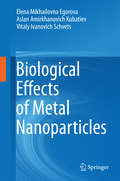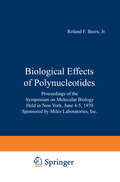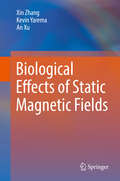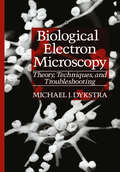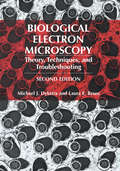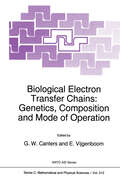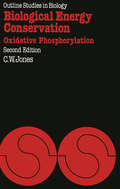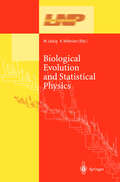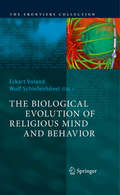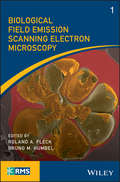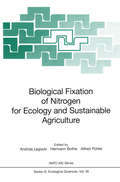- Table View
- List View
Biological Control in Latin America and the Caribbean: Its Rich History and Bright Future (CABI Invasives Series)
by Hugo César Arredondo-Bernal Jorge L. Sifontes Anobel Barba Lorena Barra-Bucarei César Basso Wagner Bettiol Fermin Blanco Helga Blanco-Metzler Claudia Carolina Antúnez Guillermo Cabrera Walsh Carmen C. Castillo Charlotte E. Causton Ronald D. Cave Edwin E. Sosa Patricia Castillo Willy Chiaravalle Ximena Cibils Dr Matthew Cock Alba Marina Cotes Luis V. Crespo Luis Devotto Moreno Francisco Ferrer Andrés France Iglesias Javier P. Franco Fermín Fuentes Fernando Gallardo-Covas Patricio G. Gallegos Victor Adolfo López Nancy M. Greco Lidcay Herrera Leopoldo Hidalgo Wendy-Ann P. Isaac Maitrie Jagroep Ayub Khan Takumasa Kondo Maria R. Manzano Maria Elena Marquez Jose Morales Sanchez Rossy Morera-Montoya Norma Mujica Jose Roberto Parra Alelino Pitty Karina Punschke Mayra Ramos Olgaly Ramos-Rodriguez Gloria Resquin Romero Adela Ribeiro Mayra G. Rodriguez Beatriz Rodriguez-Velez Phillipe Ryckewaert Colmar Serra Michelle A. Sherwood Rogelio Trabanino Alies Van Sauers-Muller Carlos Vasquez Jean-Francois Vayssieres Luis L. Vazquez Mary Whu Bruno ZachrissonThe book summarizes the history of biological control in Latin America and the Caribbean. Few publications provide historical detail and the records are, therefore, fragmented until now. By bringing information together in this book, we offer a more complete picture of important developments in biological control on this continent. There are a wealth of text, tables and references about the history of such projects, and which were successful and which failed. This will help plan future biocontrol projects. An overview is provided of the current situation in biological control for many Latin American and Caribbean countries, revealing an astonishing level of practical biological control applied in the region, making it the largest area under biological control worldwide. The final part describes new developments and speculates about the future of biological control in Latin America and the Caribbean.
Biological Control in Plant Protection: A Colour Handbook, Second Edition
by Neil Helyer Nigel D. Cattlin Kevin C. BrownThere has been a large increase in the commercial use of integrated crop/pest management methods for pest and disease control on a wide range of crops throughout the world since the first edition of this book. The completely revised second edition of the bestselling Biological Control in Plant Protection: A Color Handbook continues the objective of
Biological Control: Measures of Success
by G. Gurr Jeff Waage S. D. WrattenAs well as examining successful biological control programmes this book analyses why the majority of attempts fail. Off-target and other negative effects of biological control are also dealt with. Chapters contributed by leading international researchers and practitioners in all areas of biological control afford the book a breadth of coverage and depth of analysis not possible with a single author volume. Combined with the use of other experts to review chapters and editorial oversight to ensure thematic integrity of the volume, this book provides the most authoritative analysis of biological control published. Key aspects addressed include how success may be measured, how successful biological control has been to date and how may it be made more successful in the future. With extensive use of contemporary examples, photographs, figures and tables this book will be invaluable to advanced undergraduate and postgraduate students as well as being a `must' for all involved in making biological control successful.
Biological Control of Crop Diseases
by Samuel S. GnanamanickamWith contributions from more than 30 internationally renowned experts, this book combines coverage of theory with coverage of global practices. Highlighting the day-to-day challenges of organic crop management for cost-effective real-world application, the book explores the biological control of diseases in 12 major crops. It focuses on the use of host plant resistance through transgenics and induced systemic resistance as a part of biological control. Topics covered include the role of biocontrol agents for signalling resistance, effective ecofriendly alternative to combat bacterial, fungal, and viral infestation, and transgenic crops in disease management.
Biological Control of Crop Diseases
by Samuel S. GnanamanickamWith contributions from more than 30 internationally renowned experts, this book combines coverage of theory with coverage of global practices. Highlighting the day-to-day challenges of organic crop management for cost-effective real-world application, the book explores the biological control of diseases in 12 major crops. It focuses on the use of host plant resistance through transgenics and induced systemic resistance as a part of biological control. Topics covered include the role of biocontrol agents for signalling resistance, effective ecofriendly alternative to combat bacterial, fungal, and viral infestation, and transgenic crops in disease management.
Biological Control of Insect and Mite Pests in Iran: A Review from Fundamental and Applied Aspects (Progress in Biological Control #18)
by Javad Karimi Hossein MadadiThe book provides a reference to biological control of arthropod pests in agriculture and of public health importance in Iran. A quick glance over the literature shows a long history of biocontrol attempts in the country. Some historically important events highlighting the interest of Iranian academic, research and extension fields to the natural enemies and their applied aspects are provided. Iran, with an exception of the former USSR, was a pioneer in both basic and applied biocontrol in West Asia. The book consists of four parts: three parts for predators, parasitoids and pathogens, and last part for other approaches and analyses of the current state of biological control in Iran. The book provides the most up-to-date information on pest control and related topics of entomology in Iran. The chapters are written by scholars from major Universities and research centers in Iran.
Biological Control of Insect Pests Using Egg Parasitoids
by S. Sithanantham, Chandish R. Ballal, S. K. Jalali and N. BakthavatsalamThe theme of the book is highly relevant to the current emphasis on environment conservation, with focus on native biodiversity conservation in agro-ecosystems. The current impetus being given to organic farming and export oriented agri-hortculture in the country calls for access to relevant scientific knowledge base among the stakeholders. Research on biological pest control is more than a century old in India. Egg parasitoids, which are mainly tiny wasps, led by the family Trichogrammatidae, are the most widely utilized natural enemies for biological control globally. Over thirty countries are using these bioagents to protect over 10 million hectares of agricultural and forestry crops from many important insect pests. The book comprises 18 chapters, which are arranged in continuum, commencing with basic aspects of knowledge and ending in their utilization targets. The chapters cover broadly four areas: bio-diversity and natural occurrence of egg parasitoids, behaviour and adaptation of egg parasitoids, mass production and safe use of egg parasitoids and utilisation of egg parasitoids in different crop ecosystems. Some of the chapters cater to the needs of discipline-wise update on the current R&D scenario-like insect taxonomy, biotechnology, mass-production and quality control of the target organisms - egg-parasitoids, which are useful for laboratory scientists/researchers. There are also chapters devoted to knowledge status and scope for utilization of egg parasitoids in different target crops, which cater to requirements of field entomologists and extensionists for use in their tasks of guiding farmers/local guides. The book is different in approach, method, structure and content and ensures holistic coverage of the topic. The chapters are written by active and experienced workers in different crops and aspects and co-edited by four very experienced experts who have over three decades R&D experience in the subject. All the authors have uniformly focussed on comprehensive literature study and critical identification of knowledge gaps for future R&D, thus the book is novel in outlook, up-to-date in content and comprehensive in coverage of themes. This book will be useful for supplementary reading for MSc Agriculture and PhD Agriculture students, besides MSc/PhD research students in Zoology/Environmental Biology, who are specialising in Entomology. It would also serve as a very useful reference book for researchers worldwide, though focus is also there on Indian work. It addresses the special information needs of students and faculty, besides practitioners and extensionists in the Australasia and Africa regions and thus not limited to the R&D knowledge generated in developed countries.
Biological Control of Photosynthesis: Proceedings of a conference held at the ‘Limburgs Universitair Centrum’, Diepenbeek, Belgium, 26–30 August 1985 (Advances in Agricultural Biotechnology #19)
by R. Marcelle H. Clijsters M. Van PouckeProceedings of a Conference held at the `Limburg Universitair Centrum', Diepenbeek, Belgium, August 26-30, 1985
Biological Control of Plant Diseases: Progress and Challenges for the Future (Nato Science Series A: #230)
by E. C. Tjamos G. C. Papavizas R. J. CookThe papers contained in this book were presented at a NATO Advanced Research Workshop (ARW) held at Cape Sounion, Athens, Greece, 19-24 May, 1991. The twenty-eight more comprehensive papers represent the key subjects of the ARW covered by invited speakers. The thirty-four short papers pre sented in a research format are contributions of those invited to participate in the ARW. There was a total of 70 participants from 21 countries. The objectives of the ARW were as follows: to review current knowledge of biological control of plant diseases and plant parasitic nematodes, with emphasis on mechanisms at the molecular, cellular, organismal, and ecosystem level; to examine and expand on current concepts and synthesize new concepts; to identify and prioritize limitations in the use of biological control for plant diseases and nematodes and the scientific research needed to overcome these limitations; and to develop strategies for biological control through management of resident agents or introduction of natural or modified agents.
Biological Control of Plant-Parasitic Nematodes: Building Coherence between Microbial Ecology and Molecular Mechanisms (Progress in Biological Control #11)
by Keith G. Davies and Yitzhak SpiegelThe offered volume intends to review the biological control theme of phytonematodes from several prospects: ecological; applicative as well as commercial state of the art; understanding the mode-of-action of various biocontrol systems; interaction between the plant host, nematodes’ surface and microorganism’s; candidates for biocontrol; extrapolation of the wide knowledge existed in another systems for understanding biocontrol processes: C. elegans as a model and lessons from other natural systems; and exploiting advanced genomic tools to promote understanding biocontrol processes and thereafter improve specific biological control agents.
Biological Control of Rice Diseases (Progress in Biological Control #8)
by Samuel S. GnanamanickamThere is suf?cient need to document all the available data on biological control of rice diseases in a small volume. Part of this need rests on the global importance of rice to human life. In the ?rst chapter, I have tried to show that rice is indeed life for most people in Asia and shortages in production and availability can lead to a food crisis. While rice is cultivated in most continents, biological disease management attains special relevance to rice farmers of Africa, Asia, and also perhaps, Latin America. These farmers are resource-poor and might not be able to afford the cost of expensive chemical treatments to control devastating rice pathogens such as Magnaporthe oryzae (blast), Xanthomonas oryzae pv. oryzae (bacterial leaf blight), Rhizoctonia solani (sheath blight) and the virus, rice tungro disease. In an earlier volume that I developed under the title, Biological Control of Crop Diseases (Dekker/CRC Publishers, 2002), I included transgenic crops generated for the management of plant pathogens as biological control under the umbrella of a broad de?nition. Dr Jim Cook who wrote the Foreword for the volume lauded the inclusion of transgenic crops and induced systemic resistance (ISR) as a positive trend toward acceptance of host plant resistance as part of biocontrol. I continue to subscribe to this view.
Biological Data Integration: Computer and Statistical Approaches
by Christine Froidevaux Marie-Laure Martin-Magniette Guillem RigaillThe study of biological data is constantly undergoing profound changes. Firstly, the volume of data available has increased considerably due to new high throughput techniques used for experiments. Secondly, the remarkable progress in both computational and statistical analysis methods and infrastructures has made it possible to process these voluminous data. The resulting challenge concerns our ability to integrate these data, i.e. to use their complementary nature effectively in the hope of advancing our knowledge. Therefore, a major challenge in studying biology today is integrating data for the most exhaustive analysis possible. Biological Data Integration deals in a pedagogical way with research work in biological data science, examining both computational approaches to data integration and statistical approaches to the integration of omics data
Biological Data Integration: Computer and Statistical Approaches
by Christine Froidevaux Guillem Rigail Marie-Laure Martin MagnietteThe study of biological data is constantly undergoing profound changes. Firstly, the volume of data available has increased considerably due to new high throughput techniques used for experiments. Secondly, the remarkable progress in both computational and statistical analysis methods and infrastructures has made it possible to process these voluminous data. The resulting challenge concerns our ability to integrate these data, i.e. to use their complementary nature effectively in the hope of advancing our knowledge. Therefore, a major challenge in studying biology today is integrating data for the most exhaustive analysis possible. Biological Data Integration deals in a pedagogical way with research work in biological data science, examining both computational approaches to data integration and statistical approaches to the integration of omics data
Biological, Diagnostic and Therapeutic Advances in Alzheimer's Disease: Non-Pharmacological Therapies for Alzheimer's Disease
by Ghulam Md Ashraf Athanasios AlexiouThis book discusses the latest research into the highly prevalent neurodevelopmental disease most commonly associated with aging: Alzheimer’s disease (AD). Even after years of research, Alzheimer’s disease is still far from being cured. It presents a range of common symptoms in the form of behavioral and cognitive impairments. This book describes the symptoms and the biology behind them. The contents covers latest findings on the genetics involved and various factors and pathways influencing disease development. It also covers various non-pharmacological therapies like immunotherapy, use of natural products, and employing nanotechnology in both the detection and treatment of AD. This book also highlights the role of diet and nutrition in healthy aging. Given its scope, it offers a valuable asset for researchers and clinicians alike.
Biological Distance Analysis: Forensic and Bioarchaeological Perspectives
by Marin A. Pilloud Joseph T. HefnerBiological Distance Analysis: Forensic and Bioarchaeological Perspectives synthesizes research within the realm of biological distance analysis, highlighting current work within the field and discussing future directions. The book is divided into three main sections. The first section clearly outlines datasets and methods within biological distance analysis, beginning with a brief history of the field and how it has progressed to its current state. The second section focuses on approaches using the individual within a forensic context, including ancestry estimation and case studies. The final section concentrates on population-based bioarchaeological approaches, providing key techniques and examples from archaeological samples. The volume also includes an appendix with additional resources available to those interested in biological distance analyses.Defines datasets and how they are used within biodistance analysisApplies methodology to individual and population studiesBridges the sub-fields of forensic anthropology and bioarchaeologyHighlights current research and future directions of biological distance analysisIdentifies statistical programs and datasets for use in biodistance analysisContains cases studies and thorough index for those interested in biological distance analyses
Biological Diversity: Balancing Interests Through Adaptive Collaborative Management
by Louise E. Buck Charles C. Geisler John Schelhas Eva WollenbergWe live in a world of wide pendulum swings regarding management policies for protected areas, particularly as they affect the involvement of local people in management. Such swings can be polarizing and halt on-the-ground progress. There is a need to find ways to protect biodiversity while creating common ground and building management capacity thr
Biological Diversity: Balancing Interests Through Adaptive Collaborative Management
by Louise E. Buck Charles C. Geisler John Schelhas Eva WollenbergWe live in a world of wide pendulum swings regarding management policies for protected areas, particularly as they affect the involvement of local people in management. Such swings can be polarizing and halt on-the-ground progress. There is a need to find ways to protect biodiversity while creating common ground and building management capacity thr
Biological Diversity: Exploiters and Exploited
by Paul E. Hatcher Nick BatteyBiological Diversity takes a fresh, innovative approach to the teaching of biodiversity. Rather than detailing and cataloguing the major taxa and their evolutionary relationships, the authors have selected 18 groups of organisms and used these as a framework in which to discuss the species and their interactions with man and each other. There is a strong narrative theme throughout – the exploited and the exploiters - and, in many cases, there is emphasis on the historical context. A wide range of organisms are covered, from the unicellular to birds and mammals and with an equal consideration of plants and animals. Species have been chosen for their ability to best illustrate particular biological principles, and for their strong interaction with other species. After an introduction the book is divided into two parts: ‘Exploited’ and ‘Exploiters’. Each of the chapters, although linked to each other, forms a stand-alone essay. They are scientifically rigorous, up-to-date and do not shy away from addressing some controversial issues. Chapters have’ text boxes’ highlighting important issues and concepts, lists of further reading and references. In addition to tables and figures the book has a selection of original illustrations drawn by leading artist Steven Appleby. This fresh approach will appeal to all those interested in the biological sciences, and aims to be accessible to people with a diversity of backgrounds. It will prove particularly useful to biology students, enabling them to get to grips with important biological principles and concepts that underpin the diversity of life, and the interrelationship of humans with other groups of organisms.
Biological Diversity: Exploiters and Exploited
by Paul E. Hatcher Nick BatteyBiological Diversity takes a fresh, innovative approach to the teaching of biodiversity. Rather than detailing and cataloguing the major taxa and their evolutionary relationships, the authors have selected 18 groups of organisms and used these as a framework in which to discuss the species and their interactions with man and each other. There is a strong narrative theme throughout – the exploited and the exploiters - and, in many cases, there is emphasis on the historical context. A wide range of organisms are covered, from the unicellular to birds and mammals and with an equal consideration of plants and animals. Species have been chosen for their ability to best illustrate particular biological principles, and for their strong interaction with other species. After an introduction the book is divided into two parts: ‘Exploited’ and ‘Exploiters’. Each of the chapters, although linked to each other, forms a stand-alone essay. They are scientifically rigorous, up-to-date and do not shy away from addressing some controversial issues. Chapters have’ text boxes’ highlighting important issues and concepts, lists of further reading and references. In addition to tables and figures the book has a selection of original illustrations drawn by leading artist Steven Appleby. This fresh approach will appeal to all those interested in the biological sciences, and aims to be accessible to people with a diversity of backgrounds. It will prove particularly useful to biology students, enabling them to get to grips with important biological principles and concepts that underpin the diversity of life, and the interrelationship of humans with other groups of organisms.
Biological Diversity and International Law: Challenges for the Post 2020 Scenario
by Mar Campins Eritja Teresa Fajardo del CastilloThe book focuses on the interactions between international legal regimes related to biodiversity governance. It addresses the systemic challenges by analyzing the legal interactions between international biodiversity law and related international law applicable to economic activities, as well as issues related to the governance of biodiversity based on functional, normative, and geographic dimensions, in order to present a crosscutting, holistic approach. The global COVID-19 pandemic, the imminent revision of the Strategic Plan for Biodiversity 2011-2020, and the Aichi Targets have created the momentum to focus on the interactions between the Convention on Biological Diversity and other international environmental regimes. Firstly, it discusses the principles that inspire biodiversity-related conventional law, the soft law that conveys targets for enforcement of the Biodiversity Convention, their structural, regulatory and implementation gaps, the systemic relations arising from national interests, and the role of scientific advisory bodies in biodiversity-related agreements. The second part then addresses interactions in specific conventional frameworks, such as the law of multilateral trade and global public health, and the participation of communities in the management of genetic resources. Lastly, the third part illustrates these issues using four case studies focusing on the challenges for sustainability and marine biodiversity in small islands, the Arctic Ocean, the Caribbean Sea, and the Mediterranean Sea, as a way to strengthen a horizontal and joint approach. The book is primarily intended for academics, researchers, and students interested in international environmental law and policy and in interactions for creating conditions for fair, sustainable, and resilient environmental development. By offering an analysis of instruments and criteria for systemic relations in those areas, it will also appeal to public and private actors at the domestic and international level.
Biological Dosimetry: Cytometric Approaches to Mammalian Systems
by W. G. Eisert M. L. MendelsohnIn October 1982, a small international symposium was held at the Gesellschaft fUr Strahlen- und Umweltforschung mbH (GSF) in Munich as a satellite meeting of the IX International Conference on Analytical Cytology. The symposium focussed on cytometric approaches to biological dosimetry, and was, to the best of our knowledge, the first meeting on this subject ever held. There was strong encouragement from the 75 attendees and from others to publish a proceedings of the symposium. Hence this book, containing 30 of the 36 presentations, has been assembled. Dosimetry, the accurate and systematic determination of doses, usually refers to grams of substance administered or rads of ionization or some such measure of exposure of a patient, a victim or an experimental system. The term also can be used to describe the quantity of an ultimate, active agent as delivered to the appropriate target material within a biological system. Thus, for mutagens, one can speak of DNA dosimetry, meaning the number of adducts produced in the DNA of target cells such as bone-mar row stem cells or spermatogonia.
Biological Drug Products: Development and Strategies
by Wei Wang Manmohan SinghTested and proven solutions to the challenges of biological drug product development Biological drug products play a central role in combating human diseases; however, developing new successful biological drugs presents many challenges, including labor intensive production processes, tighter regulatory controls, and increased market competition. This book reviews the current state of the science, offering readers a single resource that sets forth the fundamentals as well as tested and proven development strategies for biological drugs. Moreover, the book prepares readers for the challenges that typically arise during drug development, offering straightforward solutions to improve their ability to pass through all the regulatory hurdles and deliver new drug products to the market. Biological Drug Products begins with general considerations for the development of any biological drug product and then explores the strategies and challenges involved in the development of specific types of biologics. Divided into five parts, the book examines: Part 1: General Aspects Part 2: Proteins and Peptides Part 3: Vaccines Part 4: Novel Biologics Part 5: Product Administration/Delivery Each chapter has been prepared by one or more leading experts in biological drug development. Contributions are based on a comprehensive review and analysis of the current literature as well as the authors' first-hand experience developing and testing new drugs. References at the end of each chapter serve as a gateway to original research papers and reviews in the field. By incorporating lessons learned and future directions for research, Biological Drug Products enables pharmaceutical scientists and students to improve their success rate in developing new biologics to treat a broad range of human diseases.
Biological Drug Products: Development and Strategies
by Wei Wang Manmohan SinghTested and proven solutions to the challenges of biological drug product development Biological drug products play a central role in combating human diseases; however, developing new successful biological drugs presents many challenges, including labor intensive production processes, tighter regulatory controls, and increased market competition. This book reviews the current state of the science, offering readers a single resource that sets forth the fundamentals as well as tested and proven development strategies for biological drugs. Moreover, the book prepares readers for the challenges that typically arise during drug development, offering straightforward solutions to improve their ability to pass through all the regulatory hurdles and deliver new drug products to the market. Biological Drug Products begins with general considerations for the development of any biological drug product and then explores the strategies and challenges involved in the development of specific types of biologics. Divided into five parts, the book examines: Part 1: General Aspects Part 2: Proteins and Peptides Part 3: Vaccines Part 4: Novel Biologics Part 5: Product Administration/Delivery Each chapter has been prepared by one or more leading experts in biological drug development. Contributions are based on a comprehensive review and analysis of the current literature as well as the authors' first-hand experience developing and testing new drugs. References at the end of each chapter serve as a gateway to original research papers and reviews in the field. By incorporating lessons learned and future directions for research, Biological Drug Products enables pharmaceutical scientists and students to improve their success rate in developing new biologics to treat a broad range of human diseases.
Biological Effects and Dosimetry of Nonionizing Radiation: Radiofrequency and Microwave Energies (Nato Science Series A: #49)
by Martino GandolfoDuring the last 35 years, there has been considerable develop ment and increase in the number of devices that emit nonionizing radiant energies. These energies such as radiofrequency including microwaves are used in all sectors of our society for military, industrial. telecommunications, medical, and consumer applications. This increase in sources of nonionizing radiant energies has resulted in growing interest on the part of government regulatory agencies, industrial and military physicians, research workers, clinicians, and environmentalists. Although there is information on biologic effects and potential hazards to man from exposure to microwave/radiofrequency energies, considerable confusion and misinformation has permeated not only the public press but also some scientific and technical publications. Because of the complexity of the interactions of nonionizing radiation in biological systems, an inter-disciplinary approach is necessary to assess and elucidate the problems that evolve as this field advances and as the use of these energies expands. It is important to maintain a proper perspective and assess realistically the biomedical effects of these radiant energies so that the worker or general public will not be unduly exposed nor will research, development and beneficial utilization of these energies be hampered or restricted by an undue concern for effects which may be nonexis tent or minimal in comparison to other environmental hazards.
Biological Effects and Dosimetry of Static and ELF Electromagnetic Fields: (pdf) (Problems in Practice)
by Martino Gandolfo A. Rindi S. M. MichaelsonBiological Effects and Health Implications of Radiofrequency Radiation
by James C. Lin Sol M. MichaelsonThe study of electromagnetic bioeffects is multidisciplinary; it draws heavily from the disciplines of physics, engineering, mathematics, biol ogy, chemistry, medicine, and environmental health. This book is about these disciplines and how they mutually integrate in the study of electromagnetic pathophysiology. Over aperiod of years, the authors have become increasingly aware of the difficulty in locating information concerning interaction of electro magnetic energy and biological tissues. There are numerous reports and publications, but no single comprehensive source in the American literature where such information is readily accessible. Regrettably, much of the importantinformation is contained in government documents and reports, some of which are inaccessible, or spread through many diverse journals, making retrieval and analysis of the material difficult. Although this book is primarily clinically oriented, it also focuses on those biophysical, biochemical, and fundamental molecular studies and findings that provide the basis for understanding the presence or absence of pathophysiological manifestations of exposure to radiofrequency, including microwave, energies. Detailed discussion and analysis of the relevant comprehensive physics, engineering, and biophysics are con tained in Chapters 2-5. Because the treatment is multidisciplinary, wherever possible analy sis is begun with basic background information that may appear elementary to some readers but is essential to understanding for those from a different discipline. Most confusion and controversies that exist in the field today arise from individuals of one discipline not appreciating basic facts or theories from another.
Biological Effects and Physics of Solar and Galactic Cosmic Radiation: Part A (Nato Science Series A: #243A)
by Charles E. Swenberg Gerda Horneck E. G. StassinopoulousSpace missions subject human beings or any other target of a spacecraft to a radiation environment of an intensity and composition not available on earth. Whereas for missions in low earth orbit (LEO), such as those using the Space Shuttle or Space Station scenario, radiation exposure guidelines have been developed and have been adopted by spacefaring agencies, for exploratory class missions that will take the space travellers outside the protective confines of the geomagnetic field sufficient guidelines for radiation protection are still outstanding. For a piloted Mars mission, the whole concept of radiation protection needs to be reconsidered. Since there is an increasing interest ci many nations and space agencies in establishing a lunar base and lor exploring Mars by manned missions, it is both, timely and important to develop appropriate risk estimates and radiation protection guidelines which will have an influence on the design and structure of space vehicles and habitation areas of the extraterrestrial settlements. This book is the result of a multidisciplinary effort to assess the state of art in our knowledge on the radiation situation during deep space missions and on the impact of this complex radiation environment on the space traveller. ]t comprises the lectures by the faculty members as well as short contributions by the students given at the NATO Advanced Study Institute "Biological Effects and Physics of Solar and Galactic Cosmic Radiation" held in Armacao de Pera, Portugal, 12-23 October, 1991.
Biological Effects and Physics of Solar and Galactic Cosmic Radiation Part B (Nato Science Series A: #243B)
by Charles E. Swenberg Gerda Horneck E. G. StassinopoulousSpace missions subject human beings or any other target of a spacecraft to a radiation environment of an intensity and composition not available on earth. Whereas for missions in low earth orbit (LEO), such as those using the Space Shuttle or Space Station scenario, radiation exposure guidelines have been developed and have been adopted by spacefaring agencies, for exploratory class missions that will take the space travellers outside the protective confines of the geomagnetic field sufficient guidelines for radiation protection are still outstanding. For a piloted Mars mission, the whole concept of radiation protection needs to be reconsidered. Since there is an increasing interest of many nations and space agencies in establishing a lunar base and lor exploring Mars by manned missions, it is both, timely and important to develop appropriate risk estimates and radiation protection guidelines which will have an influence on the design and structure of space vehicles and habitation areas of the extraterrestrial settlements. This book is the result of a multidisciplinary effort to assess the state of art in our knowledge on the radiation situation during deep space missions and on the impact of this complex radiation environment on the space traveller. It comprises the lectures by the faculty members as well as short contributions by the students given at the NATO Advanced Study Institute "Biological Effects and Physics of Solar and Galactic Cosmic Radiation" held in Armacao de Pera, Portugal, 12-23 October, 1991.
Biological Effects by Organotins
by Toshihiro HoriguchiThis book provides an overview of the induction mechanism of imposex caused by organotin compounds in gastropods, as well as fundamental information on the physiology and biochemistry of reproduction in mollusks. Are the sex hormones of gastropod mollusks vertebrate-type steroids, or neuropeptides? What about lipid disturbance and membrane toxicity due to organotin compounds? The book also discusses the latest findings on the role of nuclear receptors, such as retinoid X receptor (RXR), retinoic acid receptor (RAR) and peroxisome proliferator-activated receptor (PPAR), in the development of imposex in gastropods. Further, it describes the current state of contamination by organotins in the marine environment and gastropod imposex, with a special focus on Europe and Asia, introduces readers to analytical techniques for organotin compounds, and assesses the contamination and adverse effects of alternatives to organotin-based antifouling paints. Imposex, a superimposition of male genital tracts, such as penis and vas deferens, on female gastropod mollusks, is known as a typical phenomenon or consequence of endocrine disruption in wildlife. Imposex is typically induced by very low concentrations of organotin compounds, such as tributyltin (TBT) and triphenyltin (TPhT) from antifouling paints on ships and fishing nets. Reproductive failure may be brought about in severely affected stages of imposex, resulting in population decline and/or mass extinction. Thus, gastropod imposex has been recognized as a critical environmental pollution issue. Although gastropod imposex is also highly interesting for the biological sciences because of its acquired pseudohermaphroditism and/or sex change by certain chemicals, such as TBT and TPhT, the mechanism that induces the development of imposex remains unclear, possibly due to our limited understanding of the endocrinology of gastropod mollusks. This book offers a useful guide for professionals and students interested in the fields of aquatic biology, invertebrate physiology, ecotoxicology and environmental science.
Biological Effects of Dietary Restriction (ILSI Monographs)
by Lawrence FishbeinHow does dietary restriction affect the physiological and biochemical state of laboratory animals? How will the present conclusions affect further research? What are the implications for human health and safety assessment? These are the main questions asked in this book by leading international researchers. After a first look at feeding regimens and diets of laboratory animals, the book elaborates on a variety of age-associated toxicological and pathological endpoints including tumor development. The following sections detail the underlying mechanisms which may induce the broad spectrum of physiological and biochemical changes. This summary of current multidisciplinary research will enhance understanding of the practical applications and implications of dietary restriction.
Biological Effects of Electromagnetic Fields: Mechanisms, Modeling, Biological Effects, Therapeutic Effects, International Standards, Exposure Criteria
by Peter StavroulakisReporting new results, this book covers the subject of biological effects of EMF in its entirety. Experimental verification of the theoretical results is given when at all possible, and the book is expected to open new areas of research, providing material for university course creation.
The Biological Effects of Glutamic Acid and Its Derivatives (Developments in Molecular and Cellular Biochemistry #1)
by V. A. Najjarthe GABA increase takes place and (2) the area of the brain that may mediate the anticonvulsant Investigation of the physiology, biochemistry, activity. Three compounds that increase brain pharmacology and anatomy of GAB A and GABA GABA by distinct mechanisms were used in these containing neural systems, continues to reveal the studies: di-n-propylacetate (DPA, sodium val rich complexities associated with this neuroactive proate, Depakene(R)), amino-oxyacetic acid amino acid (see recent symposia 1,2,3). Advances (AOAA) and y-vinyl GABA (GVG). in the pharmacology of GABA-mimetic agents In the next sections, the metabolism of GABA have resulted in the development of compounds and a brief historical account of the relationship that can selectively activate GABA receptors (4,5, between GABA and anticonvulsant activity are 6, 7), inhibit the synthetic and degradative enzymes outlined followed by a discussion ofthe biochemical for GABA (8, 9) or affect the neuronal and glial and pharmacological effects of the three drugs. In uptake processes for GABA (10, 11). This has particular, the literature pertaining to the suppres already had a significant impact on our under sion of seizures and the correlation between anti standing of the role of GABA in convulsions and a convulsant action and increases in brain G ABA will range of other CNS functions including feeding be examined. (12), cardiovascular control (13), motor activity (14) and release of pituitary hormones (15). Before 1.
Biological Effects of Low Level Exposures to Chemical and Radiation (CRC Press Revivals)
by Edward J. CalabreseThis book features papers presented at a workshop discussing current knowledge about the biological effects of low level exposures (BELLE). The book is designed to help establish a scientific base for future BELLE initiatives and is focused on the issue of the toxicological implications of biological adaptations. Hormesis is considered in a broad, conceptual manner, as well as at molecular and biochemical levels. Other topics covered include the effects of low levels of radiation on biological systems, how the liver adapts to genetic insults, biostatistical considerations when designing studies that address issues associated with biological responses to low doses of chemicals and radiation, and the issues that surround the interpretation of findings from such studies.
Biological Effects of Low Level Exposures to Chemical and Radiation (CRC Press Revivals)
by Edward J. CalabreseThis book features papers presented at a workshop discussing current knowledge about the biological effects of low level exposures (BELLE). The book is designed to help establish a scientific base for future BELLE initiatives and is focused on the issue of the toxicological implications of biological adaptations. Hormesis is considered in a broad, conceptual manner, as well as at molecular and biochemical levels. Other topics covered include the effects of low levels of radiation on biological systems, how the liver adapts to genetic insults, biostatistical considerations when designing studies that address issues associated with biological responses to low doses of chemicals and radiation, and the issues that surround the interpretation of findings from such studies.
Biological Effects of Magnetic and Electromagnetic Fields
by Shoogo UenoThe International Symposium on Biological Effects of Magnetic and Electrom- netic Fields was held from September 3-4, 1993 at Kyushu University in Fukuoka . Japan . Originally, it was only intended to be an informal gathering of many scientists who had accepted my invitation to visit Kyushu University after the XXIVth General Assembly of the International Union of Radio Science (URSI), held in Kyoto prior to our symposium . However, since so many distinguished scientists were able to come, it was decided that a more formal symposium would be possible . It was a very productive symposium and, as a result, many of the guests consented that it would be a good idea to gather all the information put forth at the meeting and have it published. In addition, although they were unfortunately unable to attend the symposium . many other distinguished scientists had also expressed their wish to contribute to this effort and, in so doing. help to increase understanding in this, as yet, relatively immature field of science . The question of both positive and negative effects of magnetic and electromagnetic fields on biological systems has become more and more important in our world today as they .
Biological Effects of Magnetic Fields: Volume 2
by Madeleine F. BarnothyWe define biomagnetism broadly as the science of processes and functions in living organisms induced by static magnetic fields. Biomagnetic research has greatly increased since the publication of the first volume of this series. While much of this work has been reported in various international journals, there exists a need for this work to be collected together in one place. This book covers a rather wide area of research, both with respect to the strength of the field, ranging from "zero" to 150,000 oersteds, and with respect to the various specimens and their biological functions. It is designed primarly to help clarify the action of magnetic fields on biological systems with the hope of achieving a better understanding of the fundamental physiological processes occurring in them. In some chapters it is suggested that magnetic fields could ultimately be used in the treatment of disease. I would like to take this occasion to thank the contributors for their generous interest and willing cooperation. M. F. B. June 1969 Chicago, Illinois v CONTRIBUTORS Robert A. Abler, Varian Associates, Palo Alto, California (page 1). M. M. Alexandrovskaya, Institute of Higher Nervous Activity and Neuro physiology, Academy of Sciences, Moscow, USSR (page 215). Jena M. Barnothy, Biomagnetic Research Foundation, Evanston, Illinois (page 61). Madeleine F. Barnothy, College of Pharmacy, University of Illinois, Chicago, Illinois (pages xi, 103). Robert O. Becker, State University of New York, Upstate Medical Center, Syracuse; Veterans Administration Hospital, Syracuse, New York (page 207).
Biological Effects of Magnetic Fields: Volume 2
by Madeleine F. BarnothyStudy of the biological effect of magnetic fields is both a very old and a very recent area of investigation. A connection between health and the mysterious force of the lodestone has been suspected since the dawn of human culture. Nevertheless, only during the last decades has reliable evidence of biological effects of the magnetic field been dis covered. The purpose of this book is to bring together in one volume the present-day knowledge in all the active fields of biomagnetic research and at the same time to provide a theoretical and practical background to all scientists who wish to engage in investigations in this new disci pline. The need for such a comprehensive survey of current informa tion became evident to the editor from the interest manifested in the biomagnetic symposia and from the extended correspondence maintained by the Biomagnetic Research Foundation. It is hoped that the book will aid in attracting the interest of specialists and may thus serve as a catalyst for interdisciplinary exchange of ideas.
Biological Effects of Metal Nanoparticles
by Elena Mikhailovna Egorova Aslan Amirkhanovich Kubatiev Vitaly Ivanovich SchvetsThis book offers a comprehensive overview of recent studies conducted on the biological effects of metal nanoparticles. It also provides a solid theoretical foundation and various metal nanoparticle synthesis methods.Part I reviews the main chemical methods used for synthesizing metal nanoparticles in a solution and describes original method of biochemical synthesis, as well as some special procedures developed specifically for studying the biological activity of nanoparticles.Part II analyzes current literature on the effects of metal nanoparticles observed in microorganisms and addresses the influence of silver nanoparticles obtained by biochemical synthesis on biological objects on various organization levels, namely on microorganisms, acellular slim mold, unicellular alga, plant seeds and mammalian cells.The last section explains the central problems common in studies on the biological effects of metal nanoparticles and outlines potential uses of this trend in bio-nanotechnologies.This book is aimed at specialists, professors and students aspiring to expand their knowledge about the biological activities of metal nanoparticles and nanoparticle-containing materials.
Biological Effects of Polynucleotides: Proceedings of the Symposium on Molecular Biology, Held in New York, June 4–5, 1970 Sponsored by Miles Laboratories, Inc.
by Roland F. Jr. Beers W. BraunIn recent years our horizons regarding the role of nucleic acids in biological systems have been expanded vastly by the finding that these molecules not only carry and transmit specific infOImation but also can act as less specific triggers of antiviral factors and of immunological responses. The latter properties are of particular interest in terms of possible utilization in human and veterinary medicine and consequently led, in the last few years, to the development of a new research area that combines both fundamental and applied problems in a uniquely attractive way. Furthermore, the importance and the complexity of the problems has attracted investigators from many fields, including molecular biologists, virologists, immunologists, chemists, biophysicists, oncologists, pharmacologists, and clinicians. A discussion of new developments in this area of biological effects of polynucleotides, with particular emphasis on interferon induction and modification of immune responses, therefore, seemed a logical topic for one of the annual symposia that Miles Laboratories, Inc. , has sponsored in recent years. The manage ment of Miles accepted the suggestion with enthusiasm and thus once again earned the gratitude of the scientific community for sponsoring a catalytic meeting that was principally concerned with basic research problems and only tangentially with immediate applications. Springer-Verlag agreed to publish the proceedings of the meeting which was held at the Americana Hotel in New York City, June 4-5, 1970 and attracted an unusually large audience.
Biological Effects of Static Magnetic Fields
by Xin Zhang Kevin Yarema An XuThe book summarizes the emerging topic about the effects of SMF on biological samples ranging from single molecules, subcellular compartments, and cells to whole organisms, as well as the potential application of SMF in clinical treatment of cancer and other diseases. With the development and growing popularity of modern appliances, including MRI in the hospitals, the potential impact of magnetic fields on human health is invoking increasing concerns. At the same time, SMF has been used in the clinical treatment of tumors and other diseases for decades. However, there are still some reservations and uncertainties about these treatments, which are largely due to the differential biological effects reported in the literature. These experimental inconsistencies are mainly caused by variations such as different magnetic field types, intensities, treatment time as well as biological samples examined. This volume will help clarify some dilemmas in this field and encourage further investigations in order to achieve a better understanding of the biological effects of SMF, aiming for a rational application of SMF in clinical therapy in the near future. The book is useful for scientists doctors, and students who are interested in magnetic fields and life sciences.
Biological Electron Microscopy: Theory, Techniques, and Troubleshooting
by Michael J. DykstraIn this practical text, the author covers the fundamentals of biological electron microscopy - including fixation, instrumentation, and darkroom work - to provide an excellent introduction to the subject for the advanced undergraduate or graduate student.
Biological Electron Microscopy: Theory, Techniques, and Troubleshooting
by Michael J. Dykstra Laura E. ReussElectron microscopy is frequently portrayed as a discipline that stands alone, separated from molecular biology, light microscopy, physiology, and biochemistry, among other disciplines. It is also presented as a technically demanding discipline operating largely in the sphere of "black boxes" and governed by many absolute laws of procedure. At the introductory level, this portrayal does the discipline and the student a disservice. The instrumentation we use is complex, but ultimately understandable and, more importantly, repairable. The procedures we employ for preparing tissues and cells are not totally understood, but enough information is available to allow investigators to make reasonable choices concerning the best techniques to apply to their parti cular problems. There are countless specialized techniques in the field of electron and light microscopy that require the acquisition of specialized knowledge, particularly for interpretation of results (electron tomography and energy dispersive spectroscopy immediately come to mind), but most laboratories possessing the equipment to effect these approaches have specialists to help the casual user. The advent of computer operated electron microscopes has also broadened access to these instruments, allowing users with little technical knowledge about electron microscope design to quickly become operators. This has been a welcome advance, because earlier instru ments required a level of knowledge about electron optics and vacuum systems to produce optimal photographs and to avoid "crashing" the instruments that typically made it difficult for beginners.
Biological Electron Transfer Chains: Genetics, Composition and Mode of Operation (Nato Science Series C: #512)
by G. W. Canters E. VijgenboomFrom May 3-7,1997, the NATO Advanced Research Workshop on 'Biological Electron Transfer Chains' was organized in Tomar, Portugal. In the application for support the choice of the topic was justified as follows: "[Until recently efforts] have concentrated on the study of the structure and function of individual redox enzymes and proteins. Enough information is now available to make a start with the study of biological electron transfer (E1) at the next higher level of organization, that of the complete ET chain." The interest in the workshop was high: the majority of participants had registered before the workshop was formally announced, which illustrates the popularity of the topic within the biochemical and biophysical communities. The present volume contains a number of reports based on the lectures presented by the key speakers during the meeting. The workshop dealt with the following three themes: a) Electron transfer, which is the subject of Chapter 1. The analysis of ET at the molecular level is still fundamental for an understanding of how ET chains operate in vivo. After 40 years of research the contours of the subject are becoming clear now. b) Bacterial redox chains. This is the subject of Chapter 2. Its contents show how complicated these chains can be, often involving a number of gene clusters. Our understanding of the regulatory aspects and control mechanisms of these chains is only in its beginning.
Biological Energy Conservation: Oxidative Phosphorylation (Outline Studies in Biology)
by Colin William JonesThe student of biological science in his final years as an undergraduate and his first years as a graduate is expected to gain some familiarity with current research at the frontiers of his discipline. New research work is published in a perplexing diversity of publications and is inevitably concerned with the minutiae of the subject. The sheer number of research journals and papers also causes confusion and difficulties of assimilation. Review articles usually presuppose a background know ledge of the field and are inevitably rather restricted in scope. There is thus a need for short but authoritative introductions to those areas of modern biological research which are either not dealt with in standard introductory textbooks or are not dealt with in sufficient detail to enable the student to go on from them to read scholarly reviews with profit. This series of books is designed to satisfy this need. The authors have been asked to produce a brief outline of their subject assuming that their readers will have read and remembered much of a standard introductory textbook on biology. This outline then sets out to provide by building on this basis, the conceptual framework within which modern research work is progressing and aims to give the reader an indication of the problems, both conceptual and practical, which must be overcome if progress is to be maintained.
Biological Evolution and Statistical Physics (Lecture Notes in Physics #585)
by M. Lässig A. VallerianiThis set of lecture notes gives a first coherent account of a novel aspect of the living world that can be called biological information. The book presents both a pedagogical and state-of-the art roadmap of this rapidly evolving area and covers the whole field, from information which is encoded in the molecular genetic code to the description of large-scale evolution of complex species networks. The book will prove useful for all those who work at the interface of biology, physics and information science.
The Biological Evolution of Religious Mind and Behavior (The Frontiers Collection)
by Eckart Voland Wulf SchiefenhövelIn a Darwinian world, religious behavior - just like other behaviors - is likely to have undergone a process of natural selection in which it was rewarded in the evolutionary currency of reproductive success. This book aims to provide a better understanding of the social scenarios in which selection pressure led to religious practices becoming an evolved human trait, i.e. an adaptive answer to the conditions of living and surviving that prevailed among our prehistoric ancestors. This aim is pursued by a team of expert authors from a range of disciplines. Their contributions examine the relevant physiological, emotional, cognitive and social processes. The resulting understanding of the functional interplay of these processes gives valuable insights into the biological roots and benefits of religion.
Biological Field Emission Scanning Electron Microscopy (RMS - Royal Microscopical Society)
by Roland A. Fleck Bruno M. HumbelThe go‐to resource for microscopists on biological applications of field emission gun scanning electron microscopy (FEGSEM) The evolution of scanning electron microscopy technologies and capability over the past few years has revolutionized the biological imaging capabilities of the microscope—giving it the capability to examine surface structures of cellular membranes to reveal the organization of individual proteins across a membrane bilayer and the arrangement of cell cytoskeleton at a nm scale. Most notable are their improvements for field emission scanning electron microscopy (FEGSEM), which when combined with cryo-preparation techniques, has provided insight into a wide range of biological questions including the functionality of bacteria and viruses. This full-colour, must-have book for microscopists traces the development of the biological field emission scanning electron microscopy (FEGSEM) and highlights its current value in biological research as well as its future worth. Biological Field Emission Scanning Electron Microscopy highlights the present capability of the technique and informs the wider biological science community of its application in basic biological research. Starting with the theory and history of FEGSEM, the book offers chapters covering: operation (strengths and weakness, sample selection, handling, limitations, and preparation); Commercial developments and principals from the major FEGSEM manufacturers (Thermo Scientific, JEOL, HITACHI, ZEISS, Tescan); technical developments essential to bioFEGSEM; cryobio FEGSEM; cryo-FIB; FEGSEM digital-tomography; array tomography; public health research; mammalian cells and tissues; digital challenges (image collection, storage, and automated data analysis); and more. Examines the creation of the biological field emission gun scanning electron microscopy (FEGSEM) and discusses its benefits to the biological research community and future value Provides insight into the design and development philosophy behind current instrument manufacturers Covers sample handling, applications, and key supporting techniques Focuses on the biological applications of field emission gun scanning electron microscopy (FEGSEM), covering both plant and animal research Presented in full colour An important part of the Wiley-Royal Microscopical Series, Biological Field Emission Scanning Electron Microscopy is an ideal general resource for experienced academic and industrial users of electron microscopy—specifically, those with a need to understand the application, limitations, and strengths of FEGSEM.
Biological Field Emission Scanning Electron Microscopy (RMS - Royal Microscopical Society)
by Roland A. Fleck Bruno M. HumbelThe go‐to resource for microscopists on biological applications of field emission gun scanning electron microscopy (FEGSEM) The evolution of scanning electron microscopy technologies and capability over the past few years has revolutionized the biological imaging capabilities of the microscope—giving it the capability to examine surface structures of cellular membranes to reveal the organization of individual proteins across a membrane bilayer and the arrangement of cell cytoskeleton at a nm scale. Most notable are their improvements for field emission scanning electron microscopy (FEGSEM), which when combined with cryo-preparation techniques, has provided insight into a wide range of biological questions including the functionality of bacteria and viruses. This full-colour, must-have book for microscopists traces the development of the biological field emission scanning electron microscopy (FEGSEM) and highlights its current value in biological research as well as its future worth. Biological Field Emission Scanning Electron Microscopy highlights the present capability of the technique and informs the wider biological science community of its application in basic biological research. Starting with the theory and history of FEGSEM, the book offers chapters covering: operation (strengths and weakness, sample selection, handling, limitations, and preparation); Commercial developments and principals from the major FEGSEM manufacturers (Thermo Scientific, JEOL, HITACHI, ZEISS, Tescan); technical developments essential to bioFEGSEM; cryobio FEGSEM; cryo-FIB; FEGSEM digital-tomography; array tomography; public health research; mammalian cells and tissues; digital challenges (image collection, storage, and automated data analysis); and more. Examines the creation of the biological field emission gun scanning electron microscopy (FEGSEM) and discusses its benefits to the biological research community and future value Provides insight into the design and development philosophy behind current instrument manufacturers Covers sample handling, applications, and key supporting techniques Focuses on the biological applications of field emission gun scanning electron microscopy (FEGSEM), covering both plant and animal research Presented in full colour An important part of the Wiley-Royal Microscopical Series, Biological Field Emission Scanning Electron Microscopy is an ideal general resource for experienced academic and industrial users of electron microscopy—specifically, those with a need to understand the application, limitations, and strengths of FEGSEM.
Biological Fixation of Nitrogen for Ecology and Sustainable Agriculture (Nato ASI Subseries G: #39)
by Andrzej Legocki Hermann Bothe Alfred PühlerBiological nitrogen fixation (BNF) - the conversion of molecular nitrogen into ammonia - is one of the most important reactions in ecology and agriculture. It is performed exclusively by microbes (prokaryotes) that live in symbiosis with plants. This book summarizes the latest research on this reaction, the participating microbes and the genetics of how their relevant genes could be transferred into the plants. In the light of a more sustainable and less ecologically damaging agriculture, this is becoming an increasingly pressing issue.
